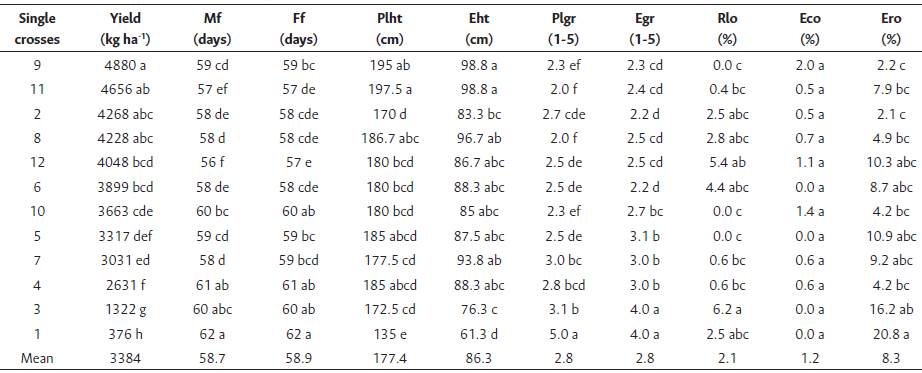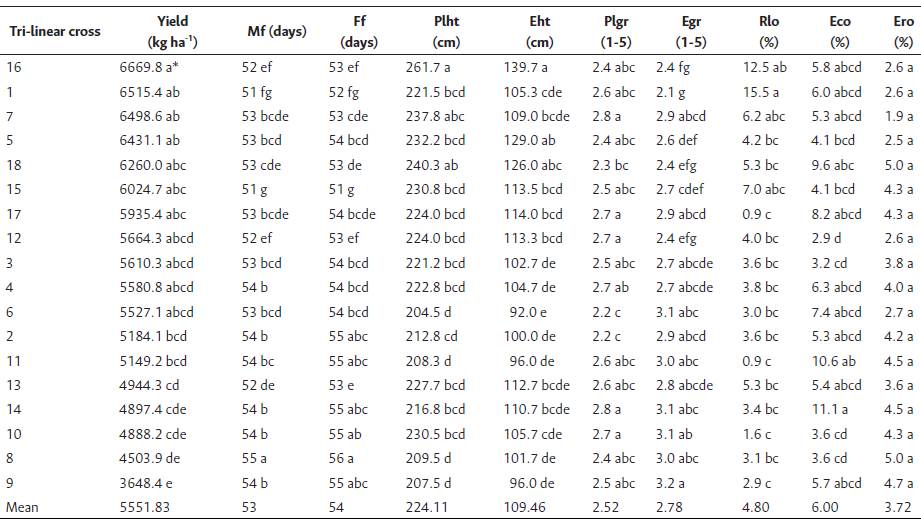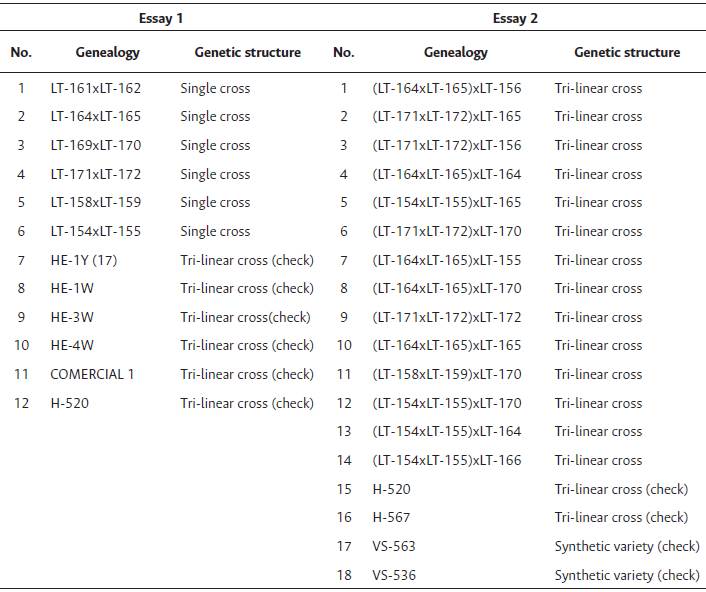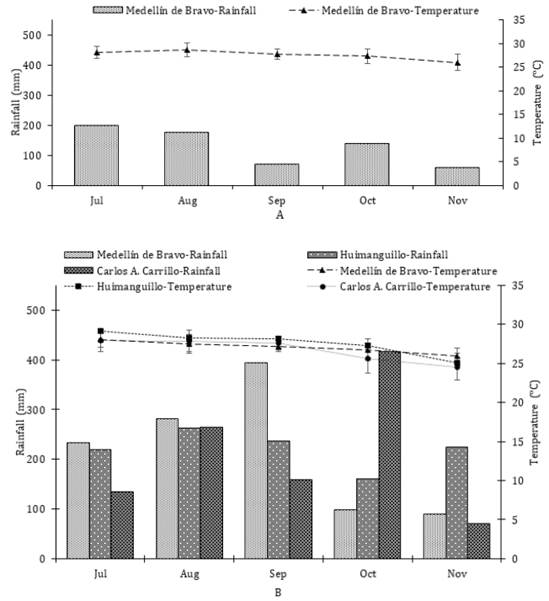Introduction
Corn (Zea mays L.) is one of the most important cereals in the world. In 2018, corn was grown in approximately 192 million hectares with a mean yield of 5600 kg ha- 1 (FAOSTAT, 2020). In Mexico, approximately 5.54 million hectares are cultivated under rainfed conditions, and 1.58 million hectares are cultivated under irrigation conditions. In these areas, a production volume of 27.2 million is obtained and a mean grain yield of 3.83 t ha-1 (SIAP, 2019). Nevertheless, there is a deficit of this grain, and each year, it is necessary to resort to importing between 15 and 17 million tons (FAS-USDA, 2020).
According to statistical data, rainfed land is cultivated in small production units that use traditional systems, although as a heterogeneous group with regard to resource management. Most of the national corn production comes from these small production units. The rainfed land fraction includes 1.5 million hectares of good to excellent agricultural quality and 3.5 million hectares are of medium quality, where the use of hybrids is feasible (Turrent et al., 2012, p.17).
In the tropical area of Mexico, the development of corn genetic improvement was initiated by the predecessor organisms of the current National Institute of Forest, Agricultural, and Livestock Research (NIFALR) such as the National Institute of Agricultural Research (NIAR) and the Office of Special Studies (OSS). The purpose was to obtain hybrids with higher yields than the regional native varieties; furthermore, to provide producers with the technology to increase their yield, to improve their profits, and to supply this basic grain. These works led to the use of three heterotic populations or groups: Synthetic Tropical Dent (STD), Tuxpeño Tropical Crystalline (TTC), and Elite Tropical Population (ETP), which formed the germplasm base of the tropics genetic improvement program in Mexico and other countries in the world.
Progress in genetic improvement was successful during the years 1950 to 1990, in which more than 16 open-pollinated varieties (OPV) and tropical hybrids of corn were released and were commercialized among producers (Technow et al., 2020); however, most of these hybrids were double-crossed, generating a high cost in seed production by the seed companies (Sumalini et al., 2018). For example, in 1994, the H-513 single cross hybrid was released (Sierra-Macias et al., 2017), which outperformed commercial varieties and hybrids by 30 % up to now; however, one problem was the low seed yield per se of the inbred lines that participate in the formation of the hybrid. Seed production of single-cross hybrids in maize is not economically feasible due to high-cost cultivation (Sumalini et al., 2018).
Due to the disadvantages in seed production of single cross hybrids starting in the year 2000, the genetic improvement program for the tropics began the formation of tri-linear crosses. These allowed to make use of the advantages offered by heterosis in commercial corn production and seed production, when using a high-yield simple cross as a female parent and inbred lines with good performance per se as a male, with a good general combinatorial aptitude and with good pollen production. Through this strategy, hybrids H-518, H-520 (Sierra-Macías et al., 2004, p.17), H-564C (Sierra-Macías et al., 2011), and recently hybrids H-567 and H-568 (Sierra-Macías et al., 2017) were released.
Meanwhile, concerning the production of corn seed the study of the agronomic traits is important in the evaluation of hybrids (Sesay et al., 2016). Likewise, it is essential to know the environment (amount and distribution of rainfall and temperature, soil, etc.) and the genotype-environment interaction (Virgen-Vargas et al., 2014). Although many studies have been done to estimate seed yield in hybrids and their parents (Andrés-Meza et al., 2013; Nelson et al., 2016; Al-Naggar et al., 2017), it is important to continue assessing the superiority of new hybrids across environments and years to benefit seed producers. Therefore, the objective of this research work was to evaluate the agronomic performance and seed yield of single and tri-linear crosses of tropical maize.
Materials and methods
Study site
The present study was an advance focused on the development of single and tri-linear crosses from tropical elite germplasm, led by the Cotaxtla Experimental Field Corn Program belonging to the NIFALR. Table 1 shows different tests performed in environments of the state of Veracruz and Tabasco, Mexico during the years 2015 and 2016, respectively.
Table 1 Physical characteristics of the evaluation environments.

Env. = environment; E1 = Medellin de Bravo, Veracruz, Mexico (2015); E2 = Medellin de Bravo, Veracruz, Mexico (2016); E3 = Carlos A. Carrillo, Veracruz, Mexico (2016); E4 = Huimanguillo, Tabasco, Mexico (2016); NL = north latitude; WL = west longitude.
Used germplasm
The present study was done through two evaluation essays: 1) during 2015, a single cross essay with 12 treatments was established, and 2) in 2016, tri-linear cross essays were done through three environments with 18 treatments (Table 2).
Experiment design.
Essay 1 was sown on July 15, 2015; two seeds were hand planted per hill and later thinned to one to obtain a plant population density of 62.500 plants ha-1. Essay 2 was established during the 2016 spring-summer cycle, through three environments with different sowing dates: Medellín de Bravo, Veracruz, Mexico (July 5), Carlos A. Carrillo, Veracruz, Mexico (July 6), and Huimanguillo, Tabasco, Mexico (July 8), respectively. In three environments, the hybrids were planted in each block in a randomized complete block design with three replications. The hybrids in each block were planted in two rows of 5.0 m length spaced 0.8 m apart with 0.2 m spacing between plants within a row, the useful plot had an area of 4 m2, with a planned population density of 62.500 plants ha-1. Both essays were sown manually, and band fertilized with a dose of 161-46 00 kg ha-1 of nitrogen, P2O5, and ICO, respectively, Urea with 46-00-00 analysis and diammonium phosphate 18-46-00 (DAP) were used as nutritional sources. The physical mixture was done with 100 kg Urea + 100 kg DAP, divided into two stages: half of the nitrogen and all the DAP were applied 15 days after sowing (das) in the V2 stage of the crop; the rest of the nitrogen was applied before panning between stages V4 and V5 of the crop. The weed control was applied with herbicide Atrazine in dose of 3 kg ha-1 to achieve complete control. The control of pests was carried out with the application of permethrin, and monochotophos to control Phyllophaga spp., Agrotis lineatus, Spodoptera frugiperda Smith, and Heliothis zea.
Data recording
During the essays, the climatic conditions such as mean monthly temperature and accumulated monthly rainfall was recorded through the meteorological stations: Paso del Toro (19° 02’ 16.8” N, 96° 08’ 06” W), and Carlos A. Carrillo (18° 16’ 15.6” N, 95° 33’ 25.2’’ W) Veracruz, Mexico, and Cardenas (18° 00’ 3.6” N, 93° 22’ 33.6” W) Tabasco, Mexico (SMN-CONAGUA, 2020). The following agronomic traits was quantified: days to 50 % anthesis, days to 50 % silking, plant and ear height, plant qualification (where 1 is the best and 5 is the worst), root lodging, and the number of ears with poor coverage, respectively. At approximately 120 das, the experiment was harvested manually, where harvest traits such as ear grade, number of rotten ears, and seed yield (kg ha-1) was recorded. Seed yield was calculated with the formula: Yield = (PC*% DM*% G*FC) / 8600; where: PC = total field weight harvested in the experimental unit, % DM = percentage of dry matter of a sample of seeds from five ears, % G = percentage of grain estimated from five ears, FC = conversion factor to obtain the seed yield per hectare, the quotient of dividing 10.000 m2 by the useful plot in m2 and, 8600 = is a constant to estimate the seed yield at a humidity of 14 %.
Statistical methods
Analyses of variance (ANOVA) and multiple comparisons of means (Duncan, < 0.05) were done on all the quantified traits. The mean values were considered significantly different when P < 0.05. Using additive main effects and multiplicative interaction (AMMI) model seed yield data was subjected to analysis of variance across environments (Genotype-environment interaction). Statistical analyses were done with the PROC GLM of the SAS/STAT® version 9.0 software (Gupta et al., 2015, p.37).
Results and discussion
Environmental characteristics of the evaluation sites
In the evaluation of single crosses of tropical corn (Table 1) during the study period that comprised the months of July to November 2015 in the Medellín de Bravo, Veracruz, Mexico environment (Figure 1A), the monthly accumulated rainfall was 643.3 mm, and the mean temperature was 27.6 °C; in this regard, a higher mean temperature occurred in August (30.1 °C) compared to November (24.3 °C) (Figure 1A). In spring-summer 2016, which corresponded to the second essay of tri-linear crosses, the mean monthly temperature conditions during July to November in the environments of Medellín de Bravo, Carlos A. Carrillo, Veracruz, México, and Huimanguillo, Tabasco, Mexico (Table 1) was 27.1, 26.7, and 27.5 °C, respectively; while the recorded rainfall was 1097.1, 1046.9, and 1103.1 mm for each environment, respectively (Figure 1B). Essentially, rainfall amounts and distribution were more suitable for plant growth in 2016.
According to Aguilar et al. (2015), the minimum recommended temperature for proper plant development is > 15 °C; contrastingly, at temperatures above 30 °C, all the physiological processes of the plant decreased significantly (Rincón-Tuexi et al., 2006). Extreme temperatures of < 15 and 35 °C during grain fill reduced number of kernels ear- 1 and kernel weight (Cicchino et al., 2010). The total accumulated rainfall throughout the development of the crop in the three experiments was greater than the reported demand for this crop finding optimal water conditions from 550 to 575, up to 800 mm (Martinez Álvarez, 2015).
Evaluation of single crosses
The data indicated that the single crosses was significantly different (P < 0.05) for all the traits evaluated, except for ear coverage variable. This suggests genetic variation within the evaluated genotypes, a situation that has already been reported in another research by Boakyewaa et al. (2019). The variation coefficients recorded ranged from 1.67 to 68.57 %, where high values were obtained in traits recorded in percentages such as: root lodging, ear cover, and rotten ears (Table 3). Also, low values of this parameter indicate reliability in the conduction of the experiment (Gupta et al., 2015, p.37).
Table 3 Statistical significance in agronomic traits in single crosses of tropical corn.

*Significant at 0.05; ** Highly significant at 0.01, according to the Duncan Test (P < 0.05); NS = non-significant; SV = source of variation; DF = degrees of freedom; Mf = male flowering; Ff = female flowering; Plht = plant height; Eht = ear height; Plgr = plant grade; Egr = ear grade; Rlo = root Lodging; Eco = ear cover; Ero = ear rot; CV = coefficient of variation.
The mean general seed yield of the evaluated hybrids was 3384 kg ha-1 (Table 4). The seed yield of the 12 single crosses fluctuated between 4880 and 376 kg ha-1 (HE-3W and LT-161xLT-162, respectively). An outstanding significant group (P < 0.05) was obtained with the HE-3W, COMERCIAL 1 (check), LT- 164xLT-165, and HE-1W hybrids. Within this group, the HE-3W hybrid produced the highest seed yield with 4880 kg ha- 1; the agronomic performance of this hybrid can be attributed to its genetic makeup. Likewise, it is important to point out that the LT- 164xLT-165 single cross participates as a female parent in the formation of the recently released tri-linear hybrid H-567 (Sierra Macías et al., 2017).
Table 4 Mean values of single crosses of tropical corn.

*Averages with different letters in the same column show significant differences (P < 0.05), according to Duncan's test; Mf = male flowering; Ff = female flowering; Plht = plant height; Eht = ear height; Plgr = plant grade, where 1 is the best and 5 is the worst; Egr = ear grade, where 1 is the best and 5 is the worst; Rlo = root lodging; Eco = ear cover; Ero = ear rot; 1 = LT-161xLT-162; 2 = LT164xLT165; 3 = LT-169 x LT-170; 4 = LT-171xLT-172; 5 = LT158xLT159; 6 = LT154xLT155; 7 = HE-1Y (17) (check); 8 = HE-1W (check); 9 = HE-3W (check); 10 = HE-4W (check); 11 = COMERCIAL 1 (check); 12 = H-520 (check).
The evaluation environment was characterized for presenting a total accumulated rainfall of 643.3 mm during the development of the crop, which corresponded to 68 % of the accumulated annual total (Figure 1A). This value is higher than that reported by Martínez Álvarez (2015).
Regarding the days to flowering (Table 4), the COMMERCIAL 1 (check) hybrid was the earliest with 57 days to 50 % anthesis and 50 % silking; in contrast, the LT-161xLT-162 single cross was the latest at 62 das. NIFALR breeders are increasingly emphasizing flowering synchronizations of male inbred lines and single cross seed , parents when advancing new hybrids tri-linear. Ángeles-Gaspar et al. (2010) mention that precocity is an important variable to denote the adaptation of genotypes to prevailing humidity conditions. The mean plant height varied from 135 to 197 cm, while ear height varied from 61 to 98 cm, respectively, with the lowest values for the single crosses of tropical lines, compared with the experimental and commercial tri-linear hybrids. Our results also revealed that plant and ear height were greatly influenced by the environment. The result for plant height corroborates with the findings of Sesay et al. (2016). These values coincide with those reported by De la Cruz-Lázaro et al. (2009) in a group of tropical corn populations. Likewise, Sener et al. (2004) reported important variations for plant height in corn hybrids.
The lowest plant and ear grades were for hybrids HE-3W, COMERCIAL 1, and HE- 1W. These same hybrids registered low percentages in the traits of root lodging, ear coverage, and ear rot (Table 4). The last trait is important since in the tropical humid region of Mexico, the combination of high temperatures and humidity causes an ideal environment for the presence of fungi like Diplodia spp., and Fusarium spp. (De Leon, 2004, p. 118). Lastly, the LT164xLT165 single cross proved to be highly productive, which represents a competitive advantage in commercial seed production (Gómez et al., 2017).
Evaluation of tri-linear crosses
The combined analysis of variance revealed significant differences (P < 0.05) between genotypes (G) in 70 % of the 10 traits registered (Table 5). Between environments (E), significant differences (P < 0.05) were also detected in 80 % of the traits, while for the GxE interaction, significant differences (P < 0.05) were found in 70 % of the traits. The variance due to the environments was found to be more important, this is to say, there was strong environmental pressure on the evaluated genotypes. The variation coefficients registered ranged from 1.69 to 74.04 %, relatively low values, suggesting that the handling of the experiments and the obtained results are reliable (Gupta et al., 2015, p.37).
Table 5 Combined analysis of variance across three environments in the state of Veracruz and Tabasco, Mexico.

*Significant at 0.05; **Highly significant at 0.01, according to the Duncan Test (P < 0.05); NS = non-significant; SV = source of variation; Gen. = genotype; Env. = environment; DF = degrees of freedom; Mf = male flowering; Ff = female flowering; Plht = plant height; Eht = ear height; Plgr = plant grade; Egr = ear grade; Rlo = root lodging; Eco = ear cover; Ero = ear rot; CV = coefficient of variation.
A group of tri-linear crosses was obtained that exceeded or equaled the recommended commercial hybrids for tropical humid regions (Table 6). Nine tri-linear hybrids and two open pollinates varieties: H-567, (LT-164xLT-165) xLT-156, (LT- 164xLT- 165) xLT-155, (LT-154xLT-155) xLT-165, VS-536, H-520, VS-563, (LT- 154xLT-155) xLT-170, (LT- 171xLT-172) xLT-156, (LT-164xLT-165) xLT-164, and (LT-171xLT-172) xLT-170 were placed in the higher yield group with 6669.8, 6515.4, 6498.6, 6431.1, 6260, 6024.7, 5935.4, 5664.3, 5580.8, and 5527.1 kg ha-1, respectively. Particularly, in this outstanding group, we can observe the presence of the H-567 tri-linear hybrid, recently released by the NIFALR corn program. Likewise, inbred lines LT-154, LT-155, and LT-156, female and male parents of the H-520 commercial hybrid are common; this hybrid is used in more than 84.000 hectares in the Mexican southeast (Sierra Macías et al., 2016). Results showed that the yielding genotypes at the testing location were different suggesting cross-over interactions for some genotypes. Yield improvement in tropical maize has been attributed to increased grain filling period, changes in morphology, and better tolerance to biotic and abiotic stresses (Gasura et al., 2013; Sierra Macías et al., 2017).
Table 6 Mean values of tri-linear crosses through three environments in the states of Veracruz and Tabasco, Mexico.

*Averages with different Letters in the same coLumn show significant differences (P < 0.05), according to Duncan's test; Mf = maLe flowering; Ff = femaLe flowering; PLht = pLant height; Eht = ear height; PLgr = pLant grade, where 1 is the best and 5 is the worst; Egr = ear grade, where 1 is the best and 5 is the worst; RLo = root Lodging; Eco = ear cover; Ero = ear rot; 1 = (LT-164xLT-165)xLT-156; 2 = (LT-171xLT-172)xLT-165; 3 = (LT-171xLT-172)xLT-156 4 = (LT-164xLT-165)xLT-164; 5 = (LT-154xLT-155)xLT-165; 6 = (LT-171xLT-172)xLT-170; 7 = (LT-164xLT-165)xLT-155; 8 = (LT-164xLT-165)xLT-170 9 = (LT-171xLT-172)xLT-172; 10 = (LT-164xLT-165)xLT-165; 11 = (LT-158xLT-159)xLT-170; 12 = (LT-154xLT-155)xLT-170; 13 = (LT-154xLT-155)xLT-164 14 = (LT-154xLT-155)xLT-166; 15 = H-520; 16 = H-567; 17 = VS-563; 18 = VS-536.
The better performance and adaptation of the tri- linear crosses with respect to the improved varieties and commercial hybrids used as controls, indicates a good source of genes from the elite genetic base of the genetic improvement program for the tropical area of Mexico. Our results suggest following the use of breeding schemes through hybridization (Hallauer et al., 2010, p.663). However, we recommend that in later studies, the proportion that the additive variance and dominance of the base population, where the inbred lines are derived represent, with respect to the total genetic variation, be reported.
All genotypes were observed to behave with an intermediate vegetative cycle with 53 days to 50 % anthesis and 54 days to 50 % silking, respectively (Table 6). It is desirable to have early genotypes whose flowering occurs before 60 days; this helps to avoid the crop coinciding with the canícula, a meteorological phenomenon where there is a short period of drought and increased temperature. Previous studies confirm that the flowering phase is the most sensitive to water stress, producing a detrimental effect on the final yield of grain or seed (Harrison et al., 2011). Liaqat et al. (2018) point that the delay in sowing decreases days to tasseling, silking and maturity, plant height, ear height, ear length, number of the row per ear, respectively. In addition, when the production of maize occurred in the rainfall season, plant height was higher because of the rainfall incidence in 2016 (224 cm), in contrast with the rainfall season in 2015 (177 cm) (Figure 1A and 1B).
On the other hand, the hybrids presented an average of 224 and 109 cm of plant and ear height, respectively. These traits are desirable, as most commercial materials commonly sown in the region are taller, which is unfavorable due to the increased risks of root lodging of the crop from the combination of rainfall with strong cold winds (Norte) prevailing in the Gulf coast (Sierra Macías, 2002). In addition, among hybrids root lodging was different, results showed that the hybrid (LT-164Xlt-165) xLT-156 were the most susceptible with more than 15 %. These results agree with those observed in other studies by Cervantes Ortiz et al. (2013) and Sánchez Hernández et al. (2019) for tropical, subtropical, and temperate areas.
About plant and ear grades, the hybrids exhibited ratings between 2 and 3, suggesting acceptable plant and ear characteristics (Table 6). The importance of recording these two traits from a subjective angle is to observe uniformity in plant height, archetype, insertion, and position of the ear, among others; in ear, the length and diameter of the ear, type of kernel, kernel size, health, among others, are observed. The analysis showed that hybrid (LT-154XLT-155) x166 had problems with more than 11 % of cover harvested ears. These traits are very important, because during grain drying, the relative humid in combination with extreme temperatures causes the presence of the fungal disease that caused ear rot. However, the observed values are not as high as those recorded in other studies (Mendoza et al., 2019). Regarding the percentages of the ear rot displayed the same trend to ear cover. This indicates that the hybridization progress has been effective; the new tri-linear crosses have been effective.
Conclusions
This work revealed that the productivity of NIFALR’s tropical maize has improved over the last 20 years. The most recently released single crosses offers easy, inexpensive, and viable technology to local seed companies in the formation of tri-linear hybrids. Furthermore, a group of highly productive tri-linear crosses with good agronomic performance was identified, which may be an option for rainfed corn producers. The LT-154, LT-155, and LT-156 lines are common as a male and female parent, suggesting a good genetic combination. The prevailing environmental conditions during the development of the experiments did not significantly influence the productivity of the hybrids. The genetic base of the corn improvement program shows high variability that can be used to continue developing inbred lines, open-pollination varieties, and highly productive corn hybrids.
















